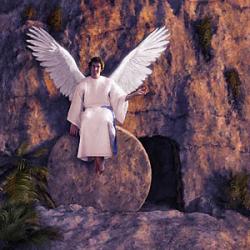So, the demons sent their vast armies against her and in the course of the battle, the other goddesses—Laksmi, Saraswati, Kali—came out of Durga's body and lay waste to the demon hosts. "Not fair!" cried one of the demon kings. "You said you'd fight us alone and look at all these helpers!"
"They aren't helpers," the Goddess retorted. "They are aspects of myself!" To prove it, she drew the other goddesses into her body, and went on to kill the demons single-handedly.
Hear Me Roar
Durga (her name means "hard to know, or hard to conquer") is the cosmic warrior, the force within consciousness that battles ignorance and darkness. Durga is the power behind dramatic breakthroughs; she's the strength you can draw on when you face challenging situations or deep backbends. Durga rides a lion, and her arms bristle with weapons, which she uses to slay an assortment of demons and other negative forces. (For me, she's also the patron goddess of the modern woman who juggles a job, children, and a yoga practice, and lives in a perpetual state of emergency while maintaining the calm of a Mona Lisa.)
In Durga's most fearsome manifestation, as Kali (Black One), she is the consuming power of time, as well as the wisdom of deep meditation. Kali is the energy that takes us beyond the ordinary world. Kali's is the love that removes every sort of veil, often by upending our concepts about ourselves and our lives. The image of Kalistands with her tongue stuck out, adorned with a garland of human heads, which, scary as they look, actually represent the sound-vibrations that manifest as thoughts, all of which are "devoured" in the silence of meditation.
Laksmi ("good fortune"), on the other hand, is the essence of everything we hold desirable. As the deity of wealth, good fortune, and happiness (her name is pronounced Luck-shmi, which is no linguistic co-incidence), she stands atop an open lotus flower, lovely as a Bollywood film star. One of her other names, Shree, means auspiciousness. Everything about Laksmi conveys beauty, goodness, and harmony.
Gold coins drip from two of her four arms, symbolizing her overflowing generosity. In some parts of India, shopkeepers and business people worship their money and ledgers as Laksmi, for she is money. But Laksmi also gives spiritual gifts—bliss, for instance, is a sure sign of her subtle presence.
Saraswati ("flowing one") dresses in white, and holds a beautifully carved stringed instrument called a veena, a book, and a rosary to represent the practice of mantra repletion. Her companion, the swan, is celebrated in Hindu iconography as the bird whose beak can separate the milk of wisdom from the water of material existence, for Saraswati's great gift is the discernment that lets us find divinity in the world.
Saraswati is the deity of language, and speech—as a hymn to Saraswati says, she is "intelligence, intelligence, intelligence." Saraswati is the poet's goddess, the deity of musicians, students, and orators, and the power behind creative inspiration.
The Dark Side
Each of these goddesses represents energies that are expressed in every arena of life—physical, intellectual, emotional, and spiritual. Yet traditionally, they are said to have two faces. When they aren't understood or recognized as expressions of the divine, we can experience these energies in deluding, excessive, or even negative ways.
For example, Durga energy in its pure form is a transformative sword that cuts through obstacles and rights imbalances. That same energy can show up as aggression or harshness, as in the cutting voice of the boss from hell, or as a sword of judgment directed at others or ourselves. When Lakshmi's abundance energy moves through the prism of ego, it can show up as greed or compulsive spending, as addictions to food or sex, as vanity or enslavement to pleasure. Saraswati's power of divine speech becomes the endless flood of information that plays on all channels of the modern world, or the uncontrollable thoughts and fantasies that parade through the mind.
The Goddess Within
The practice of deity yoga is a powerful way to free these archetypal energies from the nets cast by our egos, so they can reveal themselves in their purest, most sublime form. Moreover, when we recognize and invoke the goddesses as sources of our own powers, we train ourselves to stop identifying so personally with our skills and talents and gifts, and to open up and trust the subtle current of divine energy that is always present within us, ready to guide and mold us if we let it.
This takes a certain radical trust and an experimental spirit; one that may feel strange if you're used to identifying yourself as the doer of your action. Yet if you can embrace the idea of divine energy even experimentally, it is deeply freeing.
Becoming Laksmi
Relating to goddess energies is deity yoga, and like any other yoga, it works best if you engage it on several levels—as contemplation, as physical and behavioral practice, and through prayer and meditation.





